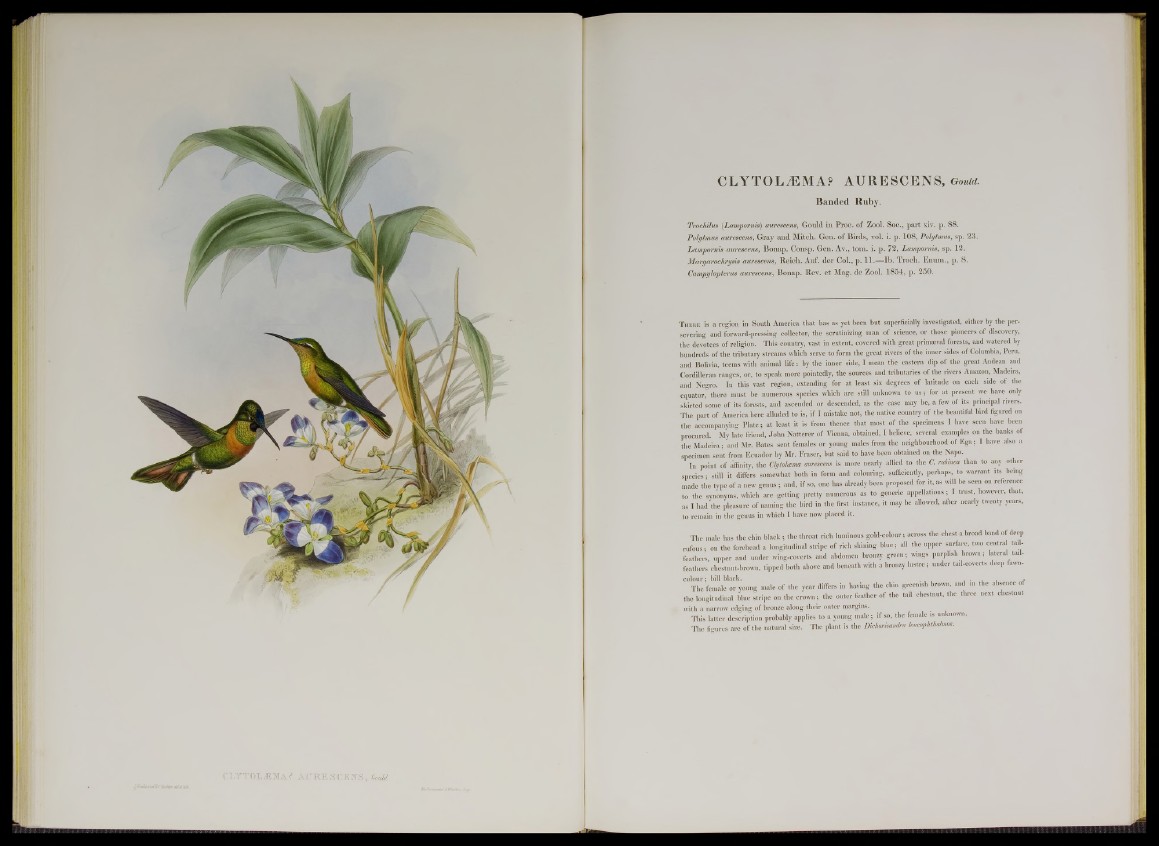
CLYTOLiEMA? AURESCENS, Qouid.
Banded Ruby.
Trochilus (Lampomis) aurescens, Gould in Proc. o f Zool. Soc., p a rt xiv. p. 88.
Polytmus aurescens, Gray and Mitch. Gen. of Birds, vol. i. p. 108, Polytmus, sp. 23.
Lampwmis aurescens, Bonap. Consp. Gen. Ay., tom. i. p . 72, Lampomis, sp. 12.
Margarochrym aurescens, Reich. Auf. der Col., p. 11.— lb . Troch. Enum., p. 8.
Campylopterm aurescens, Bonap. Rev. e t Mag. de Zool. 1854, p. 250.
T here is a region in South America that has as yet been bnt superficially investigated, either by the persevering
and forward-pressing collector, the scrutinizing man of science, or those pioneers of discovery,
the devotees of religion. This country, vast in extent, covered with great primmval forests, and watered by
hundreds of the tributary streams which serve to form the great rivers of the inner sides of Columbia, Peru,
and Bolivia, teems with animal life: by the inner side, I mean the eastern dip of the great Andean and
Cordilleran ranges, or, to speak more pointedly, the sources and tributaries of the rivers Amazon, Madeira,
and Negro. In this vast region, extending for at least six degrees of latitude on each side of the
equator, there must be numerous species which are still unknown to u s ; for at present we have only
skirted some of its forests, and ascended or descended, as the case may be, a few of its principal rivers.
The part of America here alluded to is, if I mistake not, the native country of the beautiful bird figured on
the accompanying Plate ¡ at least it is from thence that most of the specimens I have seen have been
procured. My late friend, John Natterer of Vienna, obtained, I believe, several examples on the banks of
the Madeira; and Mr. Bates sent females or young males from the neighbourhood of E g a : I have also a
specimen sent from Ecuador by Mr. Fraser, but said to have been obtained on the Napo.
In point of affinity, the Clytoleema aurescens is more nearly allied to the C. rubinea than to any other
species; still it differs somewhat both in form and colouring, sufficiently, perhaps, to warrant its being
made the type of a new genus; and, if so, one has already been proposed for it, as will be seen on reference
to the synonyms, which are getting pretty numerous as to generic appellations; I trust, however, that,
as I had the pleasure of naming the bird in the first instance, it may be allowed, after nearly twenty years,
to remain in the genus in which I have now placed it.
The male has the chin black ; the throat rich luminous gold-colour; across, the chest a broad band of deep
rufous; on the forehead a longitudinal stripe of rich shining blue; all the upper surface, two central tail-
feathers, upper and under wing-coverts and abdomen bronzy green; wings purplish brown; lateral ta i-
feathers chestnnt-brown, tipped both above and beneath with a bronzy lustre; under tail-coverts deep fawncolour:
bill black. J»
The female or young male of the year differs in having the chin greenish brown, and in the absence of
the longitudinal bine stripe on the crown; the outer feather of the tail chestnut, the three next chestnut
with a narrow edging of bronze along their outer margins.
This latter description probably applies to a young male; if so, the female is unknown.
The figures are of the natural size. The plant is the Dichorisandra leucophthalmos.